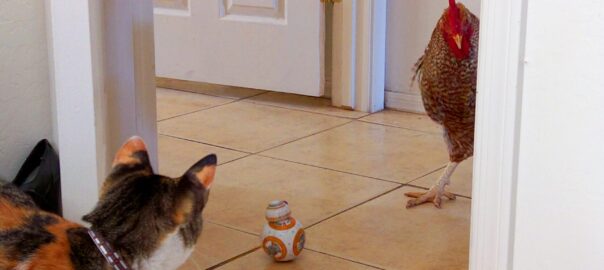By: John Peebles
“The tale of an animal is one worth telling because it is so vastly different from our own.”
Tell a story about a man, then change the man to an animal, and the story changes dramatically. The main character is not the only thing that has changed, but how the story is written. The reader is constantly aware that the main character is not human, which adds a level of surrealism and fantasy to the story. When writing about anthropomorphic animals, the author needs to consider how the animals’ natural abilities, instinct, and biology affect their development as characters, the setting, and interactions with those around them. An author can imagine and study a specific animal’s behavior but never know firsthand what the experience is genuinely like, that they must project their ideas and characteristics onto the character. The projection of the characteristics of human subjectivity onto animal sentience and behavior is called anthropomorphism.
Animals in literature cannot be written the same as human characters because the story is being told from a different relationship and perspective to the world around them. For example, Watership Down by Richard Adams tells a story through the perspective of the rabbit characters. The story would be much different if told by a human observer who only objectively describes the animal and their actions. To write this story, Adams has to imagine the thoughts and feelings of the rabbits as they struggle and progress through the plot. These elements include their limited knowledge of the world around them, their basic biology, and simple behaviors such as running and eating.
What is Gained by Using Anthropomorphic Animals as the Characters in Literature?
Writer, Juliet Kellogg Markowsky, describes four reasons for anthropomorphic writing:
- Identify. The first is being “to enable young readers to identify with the animals”. Knowing what the animal is feeling and understanding their behaviors in a specific way allows for the reader to empathize and engage with the story, which leads to Markowsky’s second reason, which is escapism.
- Escapism. “Escapism must be looked at not only escaping from a reality, but as escaping to a new form of reality which an imaginative author can provide.” .
- Variety. The third reason Markowsky describes is “an author can develop a great variety of characters in a short book with a few words if an animal is used to express attributes commonly assumed to represent the creature” . This can be done in various ways depending on which attributes are taken from the animal including an animal’s natural intelligence, physical ability, and even what they eat.
- Humor. The fourth of Markowsky’s reasons is humor. “Animals who are caricatures of certain types of people are funny to adults and children alike.” This is common in cartoons and movies.
Recognizing the Differences in Animal Characters, Just Like Human Characters
Anthropomorphizing animals creates a problem in literature due to the fact the author cannot know the actual thoughts or feelings of the animal themselves, so they must imagine what they would be like based on pre-existing human thoughts and perceptions. This is important for writers to understand when using anthropomorphic animals or any non-human creature in a story because, just as not all humans are the same, the animals differ even more, especially when considering factors such as species and breed. A larger breed of dogs will act differently from a smaller breed and be treated differently by those who come in contact with it. Each character differs from each other because of the animals’ biology, natural demeanor, and how they are perceived by the other characters they interact with throughout the story. The conflict between those who eat meat and those who are eaten will also be considered when writing a story and how that affects the plot.
How Do You Properly Anthropomorphize an Animal in a Work of Literature?
As previously stated, the author has to look at what the animal’s real-world biology is and adjust their behaviors and attributes from there to fit the story. While this is not a hard rule, it is important to consider when writing anthropomorphic characters.
There are basic worldbuilding elements that are critical when writing these kinds of stories. A characters’ psychology for instance such as a carnivore’s desire for meat and an herbivore’s fear of death are two popular traits used when telling a story about anthropomorphic animals. How does a wolf’s desire for meat affect them in a world where such actions are considered taboo and murder? What alternatives are there for such cravings or are such actions acceptable such as eating meat?
Biology
Biology is also critical when using animals as characters because the author must remind the reader that the character is something other than human through the use of behaviors and terms associated with the animal. Examples of this would be wagging tails, flapping ears, rising and falling fur, clacking of hooves, and scratching with claws. An animal’s enhanced sense of smell, sight, and hearing are ways of developing the plot and allowing feats to be accomplished that normally couldn’t be done with human characters. How often and how these traits are used is a good way to demonstrate that the character is something other than human and how they fit into the setting. An animal’s strength or size is a good way of adding tension to a story such as a bear’s large size making them harder to interact with smaller more delicate animals. This brings in the subject of prejudice against certain species or animals because of their biology which is commonly seen in stories, the most famous example being George Orwell’s Animal Farm.
Society
The animals’ society is the final point when dealing with anthropomorphism and this gets back to the world building mechanics and setting. This can be summarized into one question, who is in charge? Are the strongest on top or is there a system of equality for all species? Are those who are the most intelligent in charge like in Animal Farm? Orwell’s novel is a good example of using an animal’s distinctive and natural traits to build a miniature society. Dogs are loyal to their master; some animals are more intelligent than others while the larger ones are tasked with doing the heavier work. Then you have to consider humans and how they fit in with this animal society? Are they friend or foe? In my opinion, it is important to have both humans and animal characters coexisting together whether it be as enemies or friends. Having a human element in these types of stories adds a level of realism and allows for the reader to latch onto something within the story.
Some Things to Avoid When Writing Anthropomorphic Characters
There are pitfalls when using anthropomorphic characters in literature. Relying on cliches and stereotypes can become a crutch as well as r the reader’s engagement with a particular character. Simply telling the reader what type of animal a character is but not using any of their traits defeats the purpose of using the animal as a character in the first place. While there is no rule that says an animal character needs to act or exhibit animal behaviors to be a character, not having those traits takes away the animals’ unique qualities and lessens their role. Another pitfall I will mention is simply stating an animal’s traits inaccurately. When using animals as characters, it is crucial to have an understanding of their biology so not to make simple mistakes that a quick internet search could point out.
Why Should You Use Anthropomorphic Characters in a Story?
Is it worth going through the trouble of ensuring that you as a writer are portraying each animal accurately and respectively? In my opinion, it is worth it. I already stated Markowsky’s reasons for using anthropomorphic animals in stories, but now I want to state mine. Having animal characters allows for a way to tell a story through an artistic lens that simply cannot be told with human characters or aren’t as engaging. The struggles of characters with problems that humans cannot begin to understand because of our different biology. Anthropomorphism allows for an entirely different method of storytelling.hile it is a common practice in literature, it is not as well known or appreciated as many other genres and writing styles. The tale of an animal is one worth telling because it is so vastly different from our own.
Works Cited
Markowsky, Juliet Kellogg. Why Anthropomorphism in Children’s Literature? Elementary
English, vol. 52, no. 4, 1975, pp. 460-466.

John Peebles received his MAW from Coastal Carolina university and is pursuing a MFA in Creative Writing at Converse College.
Feature Photo by Daniel Tuttle
